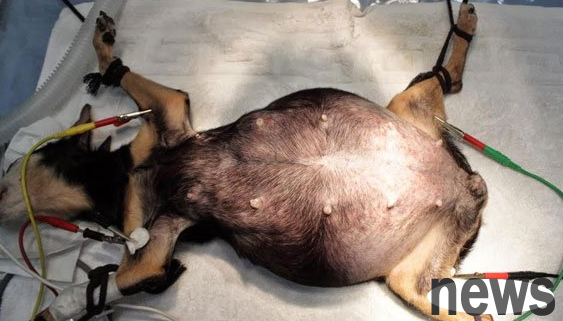Uterine pus is a disease in the late stage of dogs, characterized by abnormal endometrial abnormalities and inflammatory pathological changes, and pus is accumulated in the uterine cavity. According to whether the cervix is open or not, it is divided into atresia and open. Hyperplastic endometritis, chronic vesicle endometritis, chronic suppurative uterine inflammation, uterine abscess, etc. are difficult to distinguish from this disease, so they are collectively called uterine purulent syndrome.

[Basic Information]
Family: Reproductive Family
Symptoms: lethargy, anorexia, frequent urination, frequent thirst, vomiting, diarrhea
[Cause of the disease]
Dog uterine purulent syndrome is more common in reproductive system diseases. When a large amount of purulent exudates accumulate in the uterus and cannot be discharged, it is called uterine purulent pus. It is a disease caused by abnormal endometrial hyperplasia and secondary pathogenic microbial infection. It occurs frequently in 2 to 3 months after dogs are in estrus, and is prone to secondary urinary atresia and sepsis.
1. Endocrine factors
The uterine pus is mostly caused by the long-term effect of high concentrations of progesterone on the endometrium. High concentrations of progesterone can promote endometrial hyperplasia and reduce the mobility of the uterine muscles. Due to the stimulation of progesterone, the number of uterine glands increases in volume, strengthens the secretion function, which increases the accumulation of fluid in the uterus, providing good conditions for bacterial growth; at the same time, progesterone can also inhibit the effect of white blood cells against bacterial infection, so endometriitis in dogs is very likely to cause uterine pus accumulation. Pus in the uterine uterine accumulation can also be transferred from suppurative mastitis and other suppurative lesions. This disease can also occur if you have long-term ovarian cysts, ovarian tumors, monohorn uterus, pseudo-pregnancy and long-term stimulation of estrogen or progesterone. The occurrence of pus in dogs' uterine storing is also related to the use of progesterone. This disease can also occur with the remaining uterine tissue after ovarian hysterectomy. Estrogen can enhance the stimulating effect of progesterone on the uterus. The administration of exogenous estrogen during the estrus can increase the risk of uterine pus accumulation. Therefore, it is not recommended to inject estrogen to contraceptive birth control.
2. Microbial infections
Some bacteria in the normal vaginal bacteria are the most common pathogens of uterine infection. The most common bacteria isolated from cases of uterine pus is E. coli. In addition, Staphylococcus, Streptococcus, Pseudomonas, Proteus and other bacteria can also be isolated. When the endometrium is cystic hyperplasia, the uterine resistance is reduced, making pathogens easy to invade and reproduce, causing endometriitis, suppuration and purulence, such as mating infection.
3. Unstable estrus cycle
Older female dogs increase the chance of endometrial infection due to unstable estrus cycle.
4, other
mating, fake pregnancy, etc.
【Main Symptoms】
The clinical symptoms of dogs when they are sick occur during estrus, usually 1 to 2 months after estrus, or after injection of exogenous progesterone. The sick dog continues to hemorrhage in estrus, thicken and swollen vulva. The sick dog shows drowsiness, anorexia, frequent urination, frequent thirst, vomiting, diarrhea, etc., palpation of the abdomen, and some sick dogs experience increased body temperature. When the cervix opens, the vagina discharges purulent secretions, and often contains blood; when the cervix is atresia, the vagina cannot see secretions because the uterine secretions cannot be discharged, causing the uterus to enlarge, and the abdomen may bloat, and sometimes the dilated uterine horns can be touched. The course of the disease develops very quickly in the case of abdominal bloating, which can eventually lead to shock and death.
[Diagnostic Criteria]
is mainly based on clinical symptoms: loss of appetite or loss of appetite, increased appetite, vomiting; B-ultrasound examination: weak echoes will appear on the screen, and the uterus will appear in thick tubular or round dark areas; blood image examination: leukocytosis and rod-shaped neutrophilization, which are one of the important examination indicators for uterine purulent diseases.

1. Treatment methods Conservative therapy
The treatment principle is: promote the excretion of uterine contents and rehabilitation of the uterus, control and prevent infection, and enhance the body's resistance. Open uterine pus can be injected with oxytocin or prostate drugs to promote the elimination of pus, and use antibiotics and supplement body fluids to correct acid and base balance disorders. To treat atresia cases of uterine saccharin, patients with open cervix can first use 0.1 mg of vinylstillation or 0.1 mg of estradiol (per kilogram of body weight) to sensitize the uterus. After 2 to 4 hours, 5 to 10 U/time or 10 to 20 U/time of posterior pituitary lobe, once a day for 3 to 5 consecutive days to promote the discharge of concentrated juice. Use 10~30ml of pregnancy-promoting perfusion solution or 0.1g of Refornoil, 0.5~1.0g of tetracycline and 10~30ml of normal saline. Use once every 3~5 days, and use it 3~5 times in a row until the uterine secretions are clear and transparent. For cervical atresia cases, you can use prostaglandin 0.5~0.8 mg/intramuscular injection or side-vaginal injection for 5 consecutive days. After the cervix is opened and pus is discharged, treatment will be performed according to open cases.
2. Surgical treatment
Perform ovarian uterine removal surgery as soon as possible. This is the best treatment measure for this disease at present. It is mainly used for dogs with little value or ineffective treatment of drugs. Dogs with increased body temperature or sepsis should first use antibiotics, add adrenal corticosteroids and baking soda to the infusion, and then undergo surgery after the systemic condition is stable.
3. Systemic drug treatment
oral broad-spectrum antibiotics or intramuscular injection or intramuscular injection of penicillin, cephalosporin, aminoglycoside antibiotics, and systemic antibiotics. At the same time, the effect of oral injection of metronidazole or tinidazole tablets is better. If necessary, rehydrate, sugar supplement, add VC, dexamethasone, ATP, COA, 5% sodium bicarbonate, 10% potassium chloride, and Anabola to maintain electrolyte balance and correct autologous poisoning.
【Prevention and Treatment Methods】
Sterilization surgery is the best prevention and treatment method.
